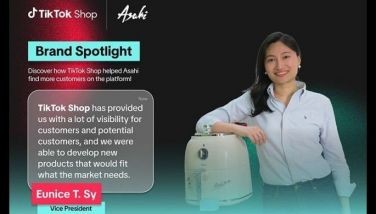Those toxins at home and in the workplace
September 26, 2006 | 12:00am
This story by Stephanie Armour came out in USA Today. A mother, Antoinette Trotter, was worried sick about her son Shawn, who was clumsy and always restless – of course, a lot of kids are, but Shawn just couldn’t sit still for a minute and was always dropping things on the floor. The six-year-old Shawn was brought to doctors who ran some tests. Results showed that Shawn’s blood contained nearly four times the acceptable level of lead for children. Mrs. Trotter, who was simply stunned, was told that her boy was being poisoned by her husband’s job. Shawn’s father Lashla, who repaired and rebuilt batteries, would return home with lead dust all over his clothes and hair. While still in his lead-contaminated clothes, he would hug and play with Shawn. Unwittingly, he was poisoning his son. (Lead can damage the brain, nerves, red blood cells, and kidneys.) The Trotters’ lawsuit pointed out that lead left Shawn with behavioral problems and a learning disability. Now 13, Shawn still struggles with school and forgets simple tasks, Armour reports. Sadly, Shawn’s mom was told that the effects of lead are permanent.
A USA Today computer data investigation found that employees in more than 35 states have unwittingly brought home toxins – like mercury, radioactive material, asbestos, pesticides, arsenic – from work sites. They unsuspectingly carried them in their cars, clothes, socks, shoes, hair, folders and briefcases. And often, it’s the children, say the health experts, who are the most at risk because of their developing organs and higher metabolic rates.
In the past 50 years, there’s been a steady climb in the incidence of children developing cancer and asthma. Our children breathe toxins every day. Yes, even while they’re sleeping, the culprit lurks. It could be hiding under your child’s bed, that’s made of polyurethane foam enclosed in vinyl covers. Every night, while he’s sleeping, the child breathes and draws these chemical molecules into his lungs.
And here’s a mouthful: Your child may be chewing or sucking on toys laced with harmful phthalate chemicals, as found in PVC (polyvinyl chloride) toys. Phthalates are added as softeners to PVC, which is hard and brittle. Greenpeace tests show that children’s teething and other toys contain up to 40 percent phthalates, a class of chemicals that has been linked to chronic hazards, including liver and kidney damage, as well as reproductive abnormalities.
DEHP, a probable human carcinogen, was phased out by US toy manufacturers in 1986. Its replacement, phthalate DINP, carries the following warning when purchased for scientific laboratory use: "May cause cancer; harmful by inhalation, in contact with skin, and if swallowed; possible risk of irreversible effects; avoid exposure and wear suitable protective clothing, gloves, and eye/face protection." Yet, when parents buy a toy containing the same DINP, they don’t see any such warning. The toy is even labeled "non-toxic."
In 1997, three teething rings were withdrawn from the Danish market after it was found that these harmless-looking teethers "liberated an extent of phthalates regarded as unacceptable for babies." The Danish study found quantities of phthalates leaching from the toys to exceed allowable limits set by the European Union for food by up to 40 times. Chewing and sucking on these PVC toys can increase the rate at which these toxic chemicals are leached.
In 1998, the European Scientific Committee noted with concern that the levels of chemical plasticizers leaching from soft PVC toys exceed safety limits. A year later, it proposed an emergency ban on sales of mouthing toys made from PVC. The permanent ban would outlaw the use of the six harmful phthalates in toys for children under three years old, while other toys for bigger boys and girls must carry a label telling parents not to let their young ones put these toys in their mouths.
Of course, parents must bring home the bacon, so to speak, and not toxins.
Indeed, we breathe toxins day in and day out, some more than the others. Like cosmetologists or beauticians or hairdressers, who are in contact with so many chemicals (some of which are toxic, like dyes and solvents), in their everyday work. Many of these chemicals are said to be mutagenic (causing damage to the genes and chromosomes). A report titled "Reproductive Disorders Due to Chemical Exposure Among Hairdressers" showed that hairdressers working in the first or second month of pregnancy and in the third through the fifth months of pregnancy were most likely to produce mentally retarded children (it is said that the human brain begins growing in the fourth week of pregnancy at a rate of over 4,000 cells per second).
To cut costs, manufacturers are replacing natural materials with petroleum-based alternatives made from synthetic chemicals.
Perhaps, as enlightened consumers, we should push for safe, non-toxic, environment-friendly products. Time to get rid of the things that poison our lives and give our children a fresh start at life.
We’d love to hear from you. E-mail us at ching_alano@yahoo.com.
A USA Today computer data investigation found that employees in more than 35 states have unwittingly brought home toxins – like mercury, radioactive material, asbestos, pesticides, arsenic – from work sites. They unsuspectingly carried them in their cars, clothes, socks, shoes, hair, folders and briefcases. And often, it’s the children, say the health experts, who are the most at risk because of their developing organs and higher metabolic rates.
In the past 50 years, there’s been a steady climb in the incidence of children developing cancer and asthma. Our children breathe toxins every day. Yes, even while they’re sleeping, the culprit lurks. It could be hiding under your child’s bed, that’s made of polyurethane foam enclosed in vinyl covers. Every night, while he’s sleeping, the child breathes and draws these chemical molecules into his lungs.
And here’s a mouthful: Your child may be chewing or sucking on toys laced with harmful phthalate chemicals, as found in PVC (polyvinyl chloride) toys. Phthalates are added as softeners to PVC, which is hard and brittle. Greenpeace tests show that children’s teething and other toys contain up to 40 percent phthalates, a class of chemicals that has been linked to chronic hazards, including liver and kidney damage, as well as reproductive abnormalities.
DEHP, a probable human carcinogen, was phased out by US toy manufacturers in 1986. Its replacement, phthalate DINP, carries the following warning when purchased for scientific laboratory use: "May cause cancer; harmful by inhalation, in contact with skin, and if swallowed; possible risk of irreversible effects; avoid exposure and wear suitable protective clothing, gloves, and eye/face protection." Yet, when parents buy a toy containing the same DINP, they don’t see any such warning. The toy is even labeled "non-toxic."
In 1997, three teething rings were withdrawn from the Danish market after it was found that these harmless-looking teethers "liberated an extent of phthalates regarded as unacceptable for babies." The Danish study found quantities of phthalates leaching from the toys to exceed allowable limits set by the European Union for food by up to 40 times. Chewing and sucking on these PVC toys can increase the rate at which these toxic chemicals are leached.
In 1998, the European Scientific Committee noted with concern that the levels of chemical plasticizers leaching from soft PVC toys exceed safety limits. A year later, it proposed an emergency ban on sales of mouthing toys made from PVC. The permanent ban would outlaw the use of the six harmful phthalates in toys for children under three years old, while other toys for bigger boys and girls must carry a label telling parents not to let their young ones put these toys in their mouths.
Of course, parents must bring home the bacon, so to speak, and not toxins.
Indeed, we breathe toxins day in and day out, some more than the others. Like cosmetologists or beauticians or hairdressers, who are in contact with so many chemicals (some of which are toxic, like dyes and solvents), in their everyday work. Many of these chemicals are said to be mutagenic (causing damage to the genes and chromosomes). A report titled "Reproductive Disorders Due to Chemical Exposure Among Hairdressers" showed that hairdressers working in the first or second month of pregnancy and in the third through the fifth months of pregnancy were most likely to produce mentally retarded children (it is said that the human brain begins growing in the fourth week of pregnancy at a rate of over 4,000 cells per second).
To cut costs, manufacturers are replacing natural materials with petroleum-based alternatives made from synthetic chemicals.
Perhaps, as enlightened consumers, we should push for safe, non-toxic, environment-friendly products. Time to get rid of the things that poison our lives and give our children a fresh start at life.
BrandSpace Articles
<
>



















